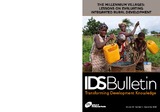Lessons from the Millennium Villages Evaluation: Where Next for Integrated Development?
| dc.contributor.author | Barnett, Chris | |
| dc.coverage.spatial | Ghana | en |
| dc.date.accessioned | 2018-11-12T14:21:07Z | |
| dc.date.available | 2018-11-12T14:21:07Z | |
| dc.date.issued | 2018-09-30 | |
| dc.identifier.citation | Barnett, C (Ed) 2018, Lessons from the Millennium Villages Evaluation: Where Next for Integrated Development?, IDS Bulletin 49.4, Brighton: IDS | en |
| dc.identifier.uri | https://opendocs.ids.ac.uk/opendocs/handle/20.500.12413/14124 | |
| dc.description.abstract | Integrated development projects seem to have largely fallen out of favour since their heyday in the 1970s and 1980s. Integrated projects are by their nature often complex and messy – and this has thrown up challenges for researchers and evaluators attempting to assess the benefits of simultaneous implementation. This IDS Bulletin explores recent evidence on integrated approaches in rural development. One of the observations in writing this IDS Bulletin, is how much the evidence base has improved, and there is now a greater understanding of where knowledge gaps exist. Amongst other examples, this IDS Bulletin looks at lessons from evaluating the Millennium Villages Project (MVP) in northern Ghana. The MVP was initiated in 2005 to implement the previous Millennium Development Goals (MDGs) in rural villages in sub-Saharan Africa. The MVP is seen as being one of the most prominent examples of integrated development in recent years, with new evidence now emerging about its effectiveness. Meanwhile, there is a renewed interest in interconnectedness, including finding ways that work across different sectors in order to implement the current Sustainable Development Goals (SDGs). Inherent in the SDGs is the recognition that the goals are interdependent, although it is noted in the articles here how integrated development approaches have yet to resonate fully with the SDG agenda. The articles are deliberately diverse, covering everything from systematic reviews to randomised trials, to mixed method designs and immersion approaches. When reviewed together, they highlight several reoccurring themes, including: the challenge of assessing synergy effects; the cost-effectiveness of integration; the value of mixing methods; and dealing with multiple outcomes on different timelines. | en |
| dc.description.sponsorship | Department for International Development (DFID) | en |
| dc.language.iso | en | en |
| dc.publisher | Institute of Development Studies | en |
| dc.relation.ispartofseries | IDS Bulletin;49.4 | |
| dc.rights | This is an Open Access article distributed under the terms of the Creative Commons Attribution Non Commercial No Derivatives 4.0 International licence (CC BY-NC-ND), which permits use and distribution in any medium, provided the original authors and source are credited, the work is not used for commercial purposes, and no modifications or adaptations are made. https://creativecommons.org/licenses/by-nc-nd/4.0/legalcode | en |
| dc.rights.uri | http://creativecommons.org/licenses/by-nc-nd/4.0/ | en |
| dc.subject | Rural Development | en |
| dc.title | Lessons from the Millennium Villages Evaluation: Where Next for Integrated Development? | en |
| dc.type | Article | en |
| dc.rights.holder | Institute of Development Studies | en |
| dc.identifier.team | Rural Futures | en |
| dc.identifier.doi | 10.19088/1968-2018.155 | |
| dcterms.dateAccepted | 2018-09-30 | |
| rioxxterms.funder | Default funder | en |
| rioxxterms.identifier.project | Default project | en |
| rioxxterms.version | VoR | en |
| rioxxterms.funder.project | 9ce4e4dc-26e9-4d78-96e9-15e4dcac0642 | en |
Files in this item
This item appears in the following Collection(s)
Except where otherwise noted, this item's license is described as This is an Open Access article distributed under the terms of the Creative Commons Attribution Non Commercial No Derivatives 4.0 International licence (CC BY-NC-ND), which permits use and distribution in any medium, provided the original authors and source are credited, the work is not used for commercial purposes, and no modifications or adaptations are made. https://creativecommons.org/licenses/by-nc-nd/4.0/legalcode


